One of the most famous wreck dives in the world, the Thistlegorm is one of the most well-preserved cargo shipwrecks to dive in the Red Sea. Diving the SS Thistlegorm should be on every divers wreck bucket list!
Quick Trip Overview
- Location: Red Sea, Hurghada, Egypt
- Closest Airport: Hurghada, Egypt
Diving at the Red Sea Quick Information
- Wet Suit: 3mm
- Water Temperature: 27-28 Celsius
- Current: There is a very strong current at times due to the wreck being located in the middle of the Suez Canal.
- Max Depth: 30m
About the Thistlegorm
The SS Thistlegorm departed for her final voyage in June 1941 from Glasglow with a destination of Alexandria, Egypt. Due to German and Italian naval and air activity in the Mediterranean, the SS Thistlegorm had to take a route around Cape Town, South Africa to bring supplies to Allied Forces in Egypt. ⠀⠀⠀⠀⠀⠀⠀⠀⠀
⠀⠀⠀⠀⠀⠀⠀⠀⠀
German intelligence had learned of a large troop transport that was destined for the area – the Queen Mary – carrying 12,000 Australian troops. Two German planes were launched from Crete in search of the troop carrier. At this time, in October 1941, the SS Thistlegorm was anchored outside the Suez Canal. ⠀⠀⠀⠀⠀⠀⠀⠀⠀⠀⠀⠀ ⠀⠀⠀⠀⠀⠀⠀⠀⠀⠀⠀⠀ ⠀⠀⠀⠀⠀⠀⠀⠀⠀⠀⠀⠀
The two German planes were unable to find the Queen Mary. Supposedly the planes were running low on fuel and opted to drop their payload on the largest boat moored outside the Suez Canal. Of 14 other ships in the area, the SS Thistlegorm was the largest. The planes dropped the bombs, which landed on cargo hold area 4. This blow was fatal as the cargo hold area was full of ammunition. ⠀⠀⠀
The SS Thistlegorm sank on 6th of October 1941 with the loss of four sailors and five members of the Royal Navy gun crew. The cargo the ship was carrying can still be seen inside the wreck: Bedford trucks, Universal Carrier armoured vehicles, Norton 16H and BSA motorcycles, Bren guns, cases of ammunition, and 0.303 rifles as well as radio equipment, Wellington boots, aircraft parts, railway wagons and two LMS Stanier Class 8F steam locomotives
Dive Season in the Red Sea
The Red Sea can be visited by a liveaboard all year round. However, the best time to visit the Red Sea for diving is between March to May, and then again from September or November. The latter is a great time to visit as most of the Caribbean and South East Asia will be in typhoon / hurricane season making other normal dive locations difficult to dive those months.
December to February is considered winter in Egypt. While you can still dive then, it is encouraged to bring some warm clothes (sweatshirts, cozy sweatpants) as the wind picks up and exiting dives can become very chilly.
Recommended Certifications for Diving Thistlegorm
For this diving Thistlegorm is recommended to have:
- Wreck Diver
- Deep Diver
- Sidemount
None of these are actually required to dive the Thistlegorm as most dive operations will take you without these.
However, this is one of the wrecks that you are able to penetrate. Therefore, having some training prior to diving this wreck will only benefit the diver. Additionally, due to the depth of the dive sidemount can help with air consumption.
What to Spot at Thistlegorm
Thistlegorm has some great wildlife opportunities as well at the dive site. During my dive there, I spotted two different turtles: one sleeping under a portion of the wreck and another swimming alongside the air defense artillery gun.
Additionally, there is the opportunity to see scorpion fish blending in with the wreck. We saw several there, trying to become one with the hull of the wreck.
My favorite though was anemonefish located right next to the center of the hull.
However, the highlight of diving Thistlegorm is not seeing the wildlife, but exploring the preserved wreck. Like most wrecks, don’t have too high of expectations of seeing anything exotic or exciting wildlife wise. However, the wreck more than makes up for the lack of ocean life you will see.
Photo Spots at the SS Thistlegorm
There are so many photo opportunities at the Thistlegorm:
- Locomotive: The Thistlegorm was carrying locomotives, and one of the trains is located just a bit away from the wreck. You may visit this one your first dive on the Thistlegorm as an orientation dive, followed by swimming along the bow of the ship.
- Air Defense Guns: Located on the bow of the wreck are some air defense artillery guns that were meant to protect the ship – obviously, they were unsuccessful.
- Cargo: There are so many great cargo shots to be had at the Thistlegorm. Ranging from the popular motorcycle photos that make the Thistlegorm so famous. Or the trucks that are still in rows in the cargo hull. Additionally, there are stacks of rifles, and ammo all around the hull – try to collect a photo of all the cargo options:
- Bedford truck
- Universal Carrier armoured vehicle
- Norton 16H and BSA motorcycle
- Case of ammunition
- 0.303 rifles
- Wellington boots
- Aircraft parts (look for the wings)
- LMS Stanier Class 8F steam locomotive
What to Expect Diving at SS Thistlegorm
The Thistlegorm is one of the most popular dive sites in the Red Sea. What does this mean? It can be pretty crowded at times.
When visiting the dive site you will likely find many boats already moored at the location with people getting in and out of the water all the time.
Don’t let this deter you though, a good dive operation keeps times of the other dive organizations to try and minimize the number of people on the wreck and avoid any backlog while diving.
During the Dive
The Thistlegorm can have a strong current. Up there as one of the strongest currents I have dove before. While entering the water we had to hold onto a line connected to the liveaboard, to then pull ourselves to the lines connected to the wreck (there are a bunch of those so make sure you are descending and ascending on the right ones) and then descend down. We had one diver that accidentally released the rope connected to the liveaboard and within seconds he was swept away to another boat. He wasn’t able to do the dive – but don’t worry he got some tea at another liveaboard before being picked up by our crew.
Safety note: if the current is worrying you, there are numerous of dive operators in the area. As stated above, even if you somehow lose your group the other dive operators will take care of you just signal for help. However, to avoid this follow the instructions of your dive master. As long as you hold onto the lines from the liveaboard and then the lines to the wreck you will be fine.
The current is only near the surface, as you descend the rope to the wreck you will feel the current decreasing. There is an occasional current along with the bow of the ship which can be mitigated by swimming close to the wreck, but within the wreck, you will feel no current.
Diving with a Camera During Strong Current: if you are like me and enjoy taking underwater photos then diving when there is a strong current can create some issues. Typically if you have a large setup the camera will be passed down to you. However, with the current at Thistlegorm that was not an option. There is a chance you will have to do negative entry (deflated BCD to sink immediately upon entry) with your camera. I did this for all three dives I had at Thistlegorm. At first I was worried, however, you just hold the camera out to the side of you and the camera was not close to hitting me at all. Takes a little muscle to keep it away but is completely manageable.
The wreck is large, and there is no way to complete the entire wreck in one dive. Most dive organizations will break it into three different dives. In our case we did this:
- Dive 1: Along the bow of the ship, and to the locomotive. Photographing the locomotive, and the air defense guns along the bow of the ship. This is when you may find the most current when diving around the exterior of the ship – just remain close to the wreck in order to mitigate it.
- Dive 2: Night dive in the cargo hold. There were fewer divers during night, and it was a unique experience diving inside of a wreck at night. This was the first sample of inside the wreck – and was the best as there was little silt from other divers during the night dive. If you can try to get a night dive inside the wreck!
- Dive 3: Day time cargo dive. This was the time that we did the famous “photo spots” of Thistle gorm. Such as the popular motorcycle location where you can look as if you’re riding the motorcycle, the one truck that has a steering wheel still intact, and revisited some of the spots that we dove during the night dive.
Visiting the wreck three times was enough to get an impressive view of the ship, and all the hidden treasures in the cargo.
Ultimately, with the depth of this dive, it will be a shorter dive. Expect only approximately 40 minutes on the wreck. This can be shorter as a portion of the time can be spent waiting for people to enter the water during the strong current, and beginning the descent to the wreck once the group was collected.
Best Practices for Diving Thistlegorm
- Remain Calm. The hull of the ship is actually fairly large for a wreck. This will not be as confined as other wrecks. While you will still have limited maneuver space there is still plenty of room.
- Keep your distance. Most likely you will be penetrating the wreck in a line. Keep your distance from the diver in front of you so that there is plenty of room for them to navigate and prevents you from getting a fin the face.
- Mind your buoyancy and fins. The wreck is enjoyed by a number of divers. Try to avoid kicking up any silt in the wreck as it will decrease the visibility in the wreck.
- Know what your dive buddy or divemaster equipment looks like. During the day dives, there are a handful of groups on the wreck. Most likely you will encounter upwards of three other dive groups while exploring. Sometimes this is at intersections where one group is proceeding one direction, and your group is going a different direction. Also ensure you know a marker (maybe someone’s fancy fins, or bright colored leggings, etc) for a quick check on which group you should be following. There was a couple of times when I emerged from the wreck to a “common area” and there would be another group there, and I would have to search for differences to see which direction mine was going (as sometimes the group is entering a different portion of the hull, or maybe ascending to exit the hull)
Equipment for Diving Thistlegorm
This is a wreck dive, therefore there are some confined portions to this dive.
Avoid entanglement. Therefore, limit the number of items dangling from your equipment. Tuck in your gauge or computer into your BCD waistband to ensure that the gauge isn’t dragging along below you. Also just check for any unnecessary items that can be dangling (or floating) off of your equipment (this is good practice for buoyancy as well).
Short fins. Dive with short fins, this enclosed area does not have much maneuver room and long fins can kick up the silt that is in the compartments.
How to Dive at Thistlegorm
The most popular way to visit the Thistlegorm is on a liveaboard in the red sea. A lot of dive operations offer a North Red Sea which focuses on diving wrecks all over the red sea. The Thistlegorm will be the most impressive wreck of the entire experience – but seeing the variety of wrecks across the North is an amazing experience.
Check out liveaboards here.


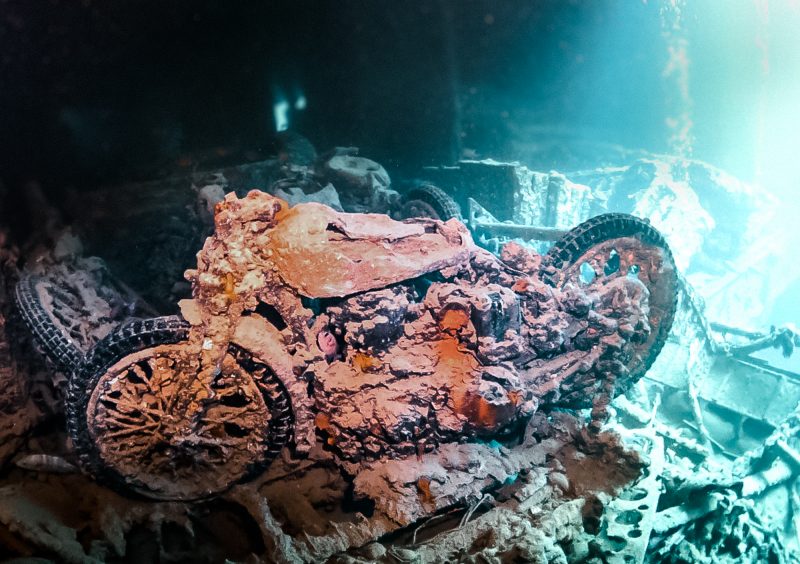
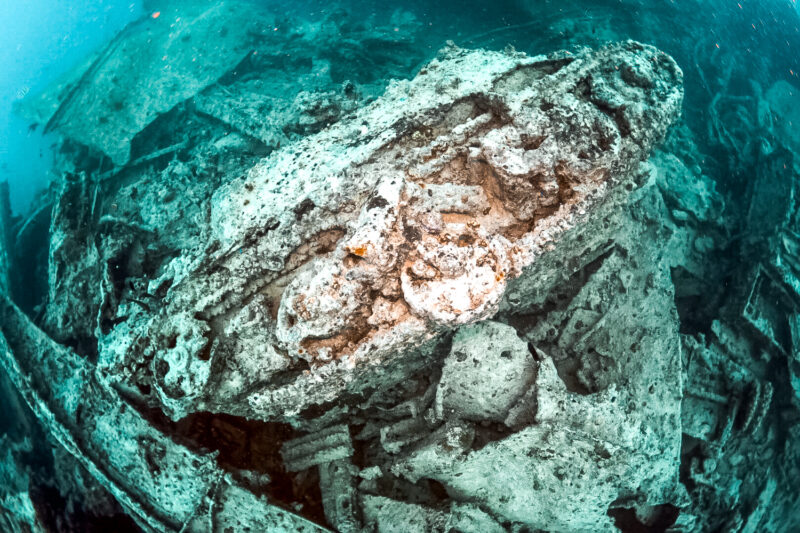

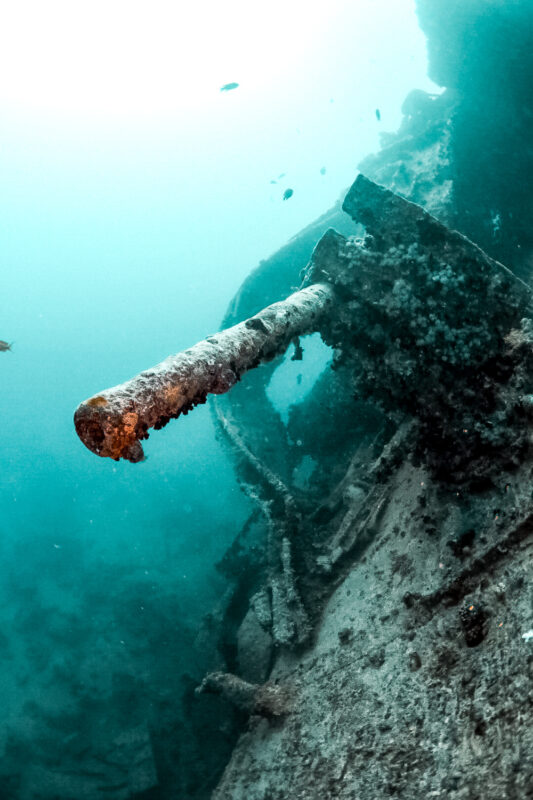



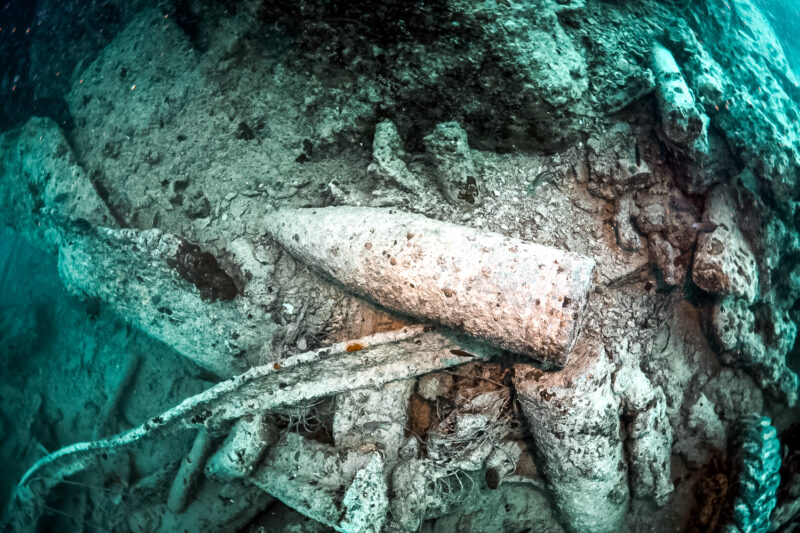
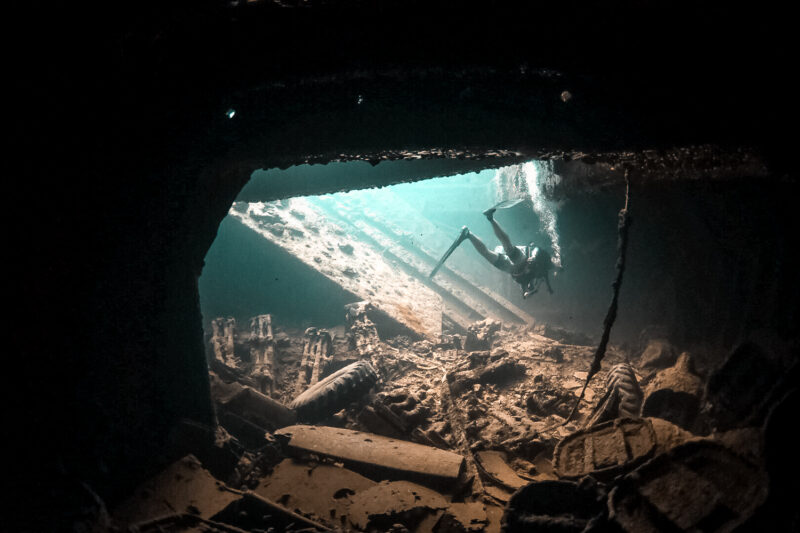
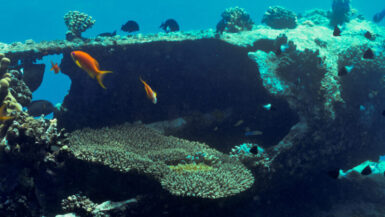
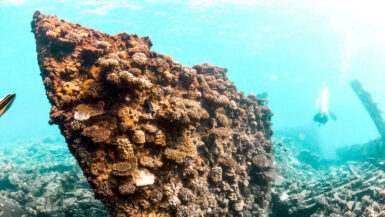
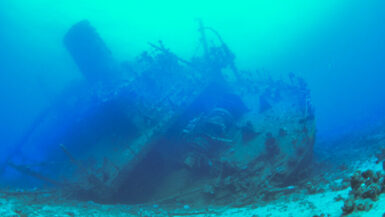
[…] PreviousNext […]
[…] Diving the SS Thistlegorm Wreck — Oceans to Alpines says: March 14, 2020 at 5:25 am […]
[…] Diving the SS Thistlegorm Wreck […]